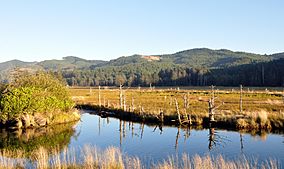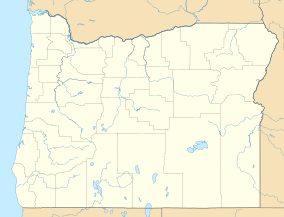Siletz Bay National Wildlife Refuge facts for kids
Quick facts for kids Siletz Bay National Wildlife Refuge |
|
|---|---|

View from U.S. Route 101 near Millport Slough
|
|
| Location | Lincoln City, Lincoln County, Oregon, United States |
| Elevation | 0 ft (0 m) |
| Established | in 1991 |
| Operator | United States Fish and Wildlife Service |
| Website | Siletz Bay NWR |
The Siletz Bay National Wildlife Refuge is a special protected area on Oregon's coast. It is a place where wildlife can live safely. This refuge is one of six National Wildlife Refuges that make up the Oregon Coast National Wildlife Refuge Complex.
The refuge is made of different parts. These parts are located north and south of the Siletz River. This is where the river flows into Siletz Bay, just south of Lincoln City.
Contents
What Can You Do at Siletz Bay Refuge?
For a long time, people could only look at the refuge from outside. They could also visit during special events. Now, there is a boat launch. This launch lets you access the water with non-motorized boats. This means you can use kayaks or canoes.
There is also a walking path called the Alder Island Nature Trail. It opened in 2017. This trail is about 0.85 miles (1.37 km) long if you walk there and back. It's a great way to explore the refuge on foot.
Why Was Siletz Bay Refuge Created?
The Siletz Bay National Wildlife Refuge was started in 1991. Its main goal was to bring the salt marsh back to its natural state. A salt marsh is a coastal wetland. It is flooded by ocean tides.
Before it became a refuge, this land was changed by people. It had been surrounded by dikes and ditches. This was done to create pastures for dairy cows.
Restoring the Salt Marsh
One part of the refuge is near Millport Slough. This is an arm of the lower Siletz River. Here, a 100-acre (40 ha) tidal marsh was restored. A tidal marsh is a wetland that is regularly covered by ocean tides.
Many groups worked together to restore this area. These groups included the United States Fish and Wildlife Service, Ducks Unlimited, and the Confederated Tribes of Siletz. They did a lot of work to help the marsh.
They broke open 220 feet (67 m) of dikes. They also removed a total of 9,300 feet (2,800 m) of other dikes. They filled in 1,200 feet (370 m) of ditches. They even added woody debris, like logs and branches. This helps to make a better home for fish.
What Can You See at the Refuge?
You might notice some interesting trees along U.S. Route 101. This road goes right through the refuge. These are skeleton trees, meaning they are dead trees without leaves. They look like they have been "starched" by salt. These trees are a reminder of when the salt marsh was diked.
Amazing Wildlife
Many birds love to live in this area. You can often see Red-tailed hawks and bald eagles. They like to rest on these tall, dead trees.
You will also find many great blue herons and great egrets living nearby. These are large, beautiful wading birds. They enjoy the marshy environment.


